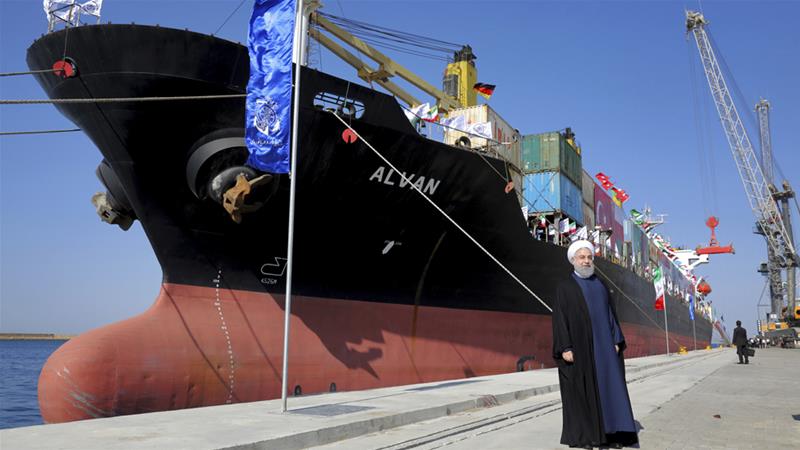As one of the world’s two doubly landlocked countries, Uzbekistan has a lot to gain from its regional neighbor Iran opening a new port alongside the Indian Ocean.
“The Chabahar port enjoys good capabilities and equipment,” said the Deputy Chairman of Uzbekistan Railways, Fazliddin Sagdullayev, on Wednesday, according to Iran Economist, adding that “in the first phase of the commissioning, this port can load and unload about 8.5 million tons of goods, but this figure will multiply in the future.”
But getting from the Uzbekistan to the ocean is not a hop, skip and a jump away. Any cargo moving by land from Uzbekistan to Iran must first move through Turkmenistan, which lies in between, or pass through northwestern Afghanistan, which also lies in between Uzbekistan and Iran.
“The rail road can play an important role in improvement of transportation and provision of goods needed in Uzbekistan and Iran,” Sagdullayev said.
The future of Chabahar promises economic development to not just Iran but Central Asia. The Chabahar-Zahedan-Sarakhs transportation corridor, which runs from southeastern Iran to southeastern Turkmenistan, could also connect Chabahar by rail and road to Afghanistan and greater Central Asia at some point in the future. The Afghan cities of Herat, Mazar-i-Sharif and Hairatan can all be linked to Uzbekistan, Kazakhstan and China; and the route may ultimately become an alternative to the China-Pakistan Economic Corridor.
During a recent visit to New Delhi, Uzbekistan’s President Shavkat Mirziyoyev invited India to help build a rail link in Afghanistan. The proposed 650 km route would connect the Afghan cities of Mazar-i-Sharif and Herat, and could be extended to Kabul later. Uzbekistan has already committed $500 million for the project, which could become another major regional connectivity project for India after its construction of the Zaranj-Delaram Highway in Afghanistan and the Shahid Beheshti port in Chabahar.
The port and eastern Iranian transport corridor will be able in the future to cooperate with the Central Asia Regional Economic Cooperation (CAREC) Program and connect its rail and road networks to economic markets in the Persian Gulf and the Indian Ocean through Iranian roads and railroads. As Uzbekistan is pursuing access routes via Iran to the Persian Gulf, officials are very interested in connecting its railroads with the port.
While construction has not yet begun, the gathering in Tehran on Tuesday resulted in the signing of the International Transport and Transit Corridor Agreement, a coordinating document for the implementation of plans to link Chabahar northward, between high-ranking transportation officials of Iran, India and Afghanistan. To provide solutions for optimizing and facilitating the transit and transportation of goods along the foreseeable routes, the use of the potential of different corridors, especially the North-South Corridor, was emphasized in the document.
The call for the development of a trade relationship between Iran and Uzbekistan is not new. In October 2017, an Uzbekistani delegation signed agreements worth $25 million for the supply of agricultural and textile products with Iran. Uzbekistan is also willing to buy crude oil from Iran, but due to Uzbekistan's lack of access to the Caspian Sea or a direct pipeline to Iran, the fuel must be exported by land or via railroad.
In a meeting with Iranian businessmen in the central province of Markazi on October 15, Uzbekistan’s Ambassador to Iran Bakhodir Abdullaev said that increasing the value of trade between Uzbekistan and Iran to $1 billion is one of the top priorities of the Uzbekistani government. Currently trade stands at about $400 million per year.
A total of 117 factories are active in Uzbekistan that are jointly owned by Iranian-Uzbekistani investors.







 Azerbaijan and Armenia started the process of demarcation of their border on Tuesday, with the installation of the first border markers based on ge...
Azerbaijan and Armenia started the process of demarcation of their border on Tuesday, with the installation of the first border markers based on ge...
 Armenian sappers commenced on Monday mine-clearance operations in the territories adjacent to the Saint Mary Church in village of Voskepar (Armenia...
Armenian sappers commenced on Monday mine-clearance operations in the territories adjacent to the Saint Mary Church in village of Voskepar (Armenia...
 Russian Foreign Minister Sergei Lavrov has reasserted that Moscow has no intentions to stop the fighting in Ukraine, even if peace talks commence.
Russian Foreign Minister Sergei Lavrov has reasserted that Moscow has no intentions to stop the fighting in Ukraine, even if peace talks commence.
 Iran’s Foreign Minister, Hossein Amir-Abdollahian, has labeled a foiled Israeli drone attack in certain parts of the country as a "failure" for Isr...
Iran’s Foreign Minister, Hossein Amir-Abdollahian, has labeled a foiled Israeli drone attack in certain parts of the country as a "failure" for Isr...



